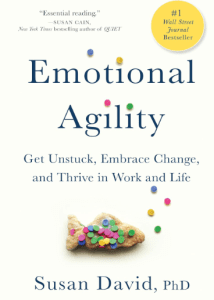
Introduction to Emotional Agility: From Susan David PhD
$32.00
This course is no longer available
Dr. Susan David states “The way we engage with our emotions shapes all aspects of our life.” In her book “Emotional Agility; Get Unstuck, Embrace Change, and Thrive in Work and Life” she discusses the power of learning how to hold, listen, and actively use emotions in a way that moves us forward with our goals in life. This training will look at the science behind the concept so emotional agility and how we can teach this flexibility to clients who feel stuck.
Upon completion of the training, participants will be able to:
- Define emotional agility
- Understand how to discuss this concept with clients in session
- Relay the steps of emotional agility to help clients become more flexible with emotions and changes in life
Social workers completing this course receive 2 Clinical asynchronous continuing education credits.
For other board approvals, this course qualifies for 2 hours of Clinical, Evidence Based Practices, and General Skill Building continuing education training.
Course Instructor: Stacy Blankenship, LCSW
Recording Date: 5/8/2024
Recorded Live Webinar with downloadable presentation slides and/or handouts, evaluation, and a required quiz. The learner is required to pass with a 70% or higher to achieve the CE certificate of completion. The learner is able to reset the test until a satisfactory score is achieved. CE Training Workshops, LLC, provider #1770, is approved as an ACE provider to offer social work continuing education by the Association of Social Work Boards (ASWB) Approved Continuing Education (ACE) program. Regulatory boards are the final authority on courses accepted for continuing education credit. ACE provider approval period: 8/2/2022 – 8/2/2025. CE Training Workshops, LLC has been approved by NBCC as an Approved Continuing Education Provider, ACEP No. 7091. Programs that do not qualify for NBCC credit are clearly identified. CE Training Workshops, LLC is solely responsible for all aspects of the programs. System Requirements: Firefox, Chrome, Brave, Safari, Edge on any modern operating system (Windows, MacOS, Linux, Android, iOS). A desktop browser is recommended. We do not provide support resources for issues encountered using a mobile device. For more information about our policies and board approval statements, please visit our FAQS page.
Stacy Blankenship, LCSW is a Licensed Clinical Social Worker and an intensively trained in Dialectical Behavioral Therapist completing her training at The Linehan Institute in 2015.
Introduction to Emotional Agility: From Susan David PhD (2 HR) Syllabus
I. Foundations of Emotional Agility
- Define emotional agility as the ability to recognize, accept, and adapt to emotions
- Differentiate between emotional agility and emotional rigidity
- Understand how rigid patterns and past conditioning interfere with present awareness
- Introduce Susan David’s research and its integration of DBT, ACT, CBT, and self-compassion
II. Emotional Rigidity and Its Patterns
- Identify the causes of rigidity such as fear of vulnerability, cultural norms, trauma, and need for control
- Explore behavioral signs including bottling emotions, false positivity, and brooding
- Understand common “hooks” including monkey-mindedness, thought-blaming, outdated stories, and righteousness
III. The Four Key Principles of Emotional Agility
- Showing Up: acknowledging thoughts and emotions with curiosity and self-compassion
- Stepping Out: detaching from emotions to gain perspective and respond wisely
- Walking Your Why: aligning actions with core values and long-term goals
- Moving On: taking intentional steps toward resilience and personal growth
IV. Techniques for “Showing Up”
- Practice self-compassion using yin (soothing) and yang (protective) methods
- Utilize the emotional pyramid of needs to understand deeper emotional drives
- Incorporate the PLEASED skill for physical and emotional regulation
- Strengthen relational support through connection-building exercises
V. “Stepping Out” Practices
- Cultivate mindfulness and awareness that the self is separate from passing emotions
- Use reframing techniques such as “I’m having the thought that…”
- Apply six detachment strategies including naming emotions, perspective-shifting, and humor
- Encourage talking to oneself in the third person to gain emotional distance
VI. “Walking Your Why” and Values Clarification
- Clarify personal values and explore their role in behavior and decision-making
- Explore steps to living by one’s own values rather than those imposed by others
- Use reflective questions to help clients identify meaningful life directions
- Address goal conflicts through value-aligned thinking
VII. “Moving On” Through Tiny Tweaks and Big Shifts
- Emphasize the power of small, intentional behavior changes
- Redefine goals using intrinsic motivation and growth mindset principles
- Apply strategies like environmental modification, habit stacking, and precommitment
- Practice mental contrasting to balance optimism with realism
VIII. The See-Saw Principle and Resilience Building
- Balance competence with healthy challenge to foster growth
- Recognize the optimal development zone at the edge of one’s ability
- Use emotional agility to discern when to persist and when to let go
- Strengthen grit and flexibility to adapt to changing goals and circumstances


